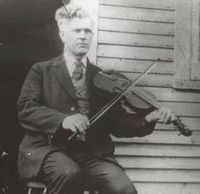Annotation:Gigue du Forgeron (1): Difference between revisions
No edit summary |
No edit summary |
||
| (18 intermediate revisions by 3 users not shown) | |||
| Line 1: | Line 1: | ||
---------- | |||
---- | {{TuneAnnotation | ||
|f_tune_annotation_title=https://tunearch.org/wiki/Annotation:Gigue_du_Forgeron_(1) > | |||
'''GIGUE DU FORGERON''' (Blacksmith's Dance). French-Canadian, Jig. D Major. Standard tuning (fiddle). AA'BB'. | |f_annotation='''GIGUE DU FORGERON''' (Blacksmith's Dance). AKA and see "[[Reel du Forgeron]]." French-Canadian, Jig (6/8 time). D Major. Standard tuning (fiddle). AA'BB'. Recorded by Québec fiddler Joseph Allard [http://www.collectionscanada.gc.ca/gramophone/028011-1049-e.html] [http://www.thecanadianencyclopedia.com/index.cfm?PgNm=TCE&TCE_Version=U&ArticleId=U0000051&mState=1] in 1937. See also the closely related "[[Doc Boyd's Jig]]," a 1933 composition by Ontario fiddler John Burt, of which "Gigue du Forgeron" may be a derivative. A ''gigue'' in Québec is a stepdance, and the name attached to a tune simply means a vehicle for stepdancing, no matter what the meter. | ||
[[File:allard.jpg|200px|thumb|left|Josephn Allard]] See also "[[Republican Set (The)]]", printed by Bayard (1981), and "[[Old Jubiter]]" in Ford's collection (1940). The jig seems to have been widespread in the northern United States and Great Lakes region, as well as in Canada, albeit under no predominant or fixed title. | |||
|f_source_for_notated_version=Joseph Allard (1873-1947, Woodland, Montréal, Québec) [Cuillerier, Hart & Sandell]. | |||
|f_printed_sources=Cuillerier ('''Joseph Allard'''), 1992; p. 9. Hart & Sandell ('''Dance ce Soir'''), 2001; No. 12, pp. 45-46. | |||
|f_recorded_sources=Bluebird B-1104-a (78 RPM), Joseph Allard (1937). | |||
'' | |f_see_also_listing=Eric Lortie's Indentitairs Québécois [http://www.mustrad.udenap.org/tounes/TQ291_gigue_du_forgeron.html]<br> | ||
Hear Allard's version at The Virtual Gramophone [https://www.collectionscanada.ca/obj/m2/f7/14581.mp3]<br> | |||
See/hear at tutorial by Sébastien Deshaies at Musique Folklorique du Quebec [https://www.youtube.com/watch?v=2KmpiWBllMA]<br> | |||
}} | |||
------------- | |||
Eric Lortie's Indentitairs Québécois [http://www.mustrad.udenap.org/tounes/TQ291_gigue_du_forgeron.html]<br> | |||
<br> | |||
<br> | |||
---- | |||
Latest revision as of 23:22, 22 May 2023
X:1 T:Gigue du Forgeron [1] C:Joseph Allard M:6/8 L:1/8 Z:Transcribed by Bruce Osborne K:D A|dcd AFA|dfb a2 f|gfg Ace|dfd AFA|! dcd AFA|dfb a2 f|gfg Ace|d2 d d2:|! |:g|b3 -bag|faa agf|gfg Ace|ba^g a2 a|! gbb bag|faa agf|gfg Ace|d2 d d2:|!
GIGUE DU FORGERON (Blacksmith's Dance). AKA and see "Reel du Forgeron." French-Canadian, Jig (6/8 time). D Major. Standard tuning (fiddle). AA'BB'. Recorded by Québec fiddler Joseph Allard [1] [2] in 1937. See also the closely related "Doc Boyd's Jig," a 1933 composition by Ontario fiddler John Burt, of which "Gigue du Forgeron" may be a derivative. A gigue in Québec is a stepdance, and the name attached to a tune simply means a vehicle for stepdancing, no matter what the meter.


